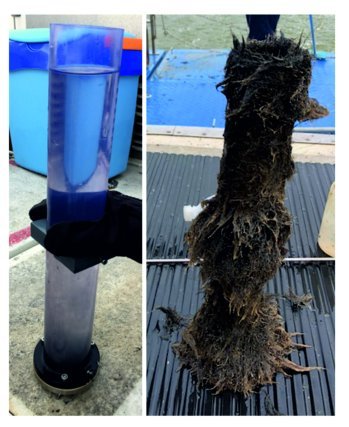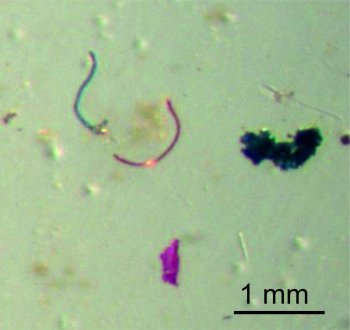Microplastics are a global problem.
On the hunt for microplastics
A wave hits the boat and splashes water on my face. I wipe my eyes with my sleeve while using the other hand to grip tightly onto the rope extending down into the water. There is a precious catch being lifted from the water: a sediment trap that I use to monitor the accumulation of microplastics in Halikonlahti bay within the inner Archipelago Sea.Published 7.12.2023
Text: Saija Saarni
Image: Shutterstock
Editing: Viestintätoimisto Jokiranta Oy
The sediment trap is a simple device comprised of two collector tubes that are connected to a metal body and anchored to the bottom of sea with a weight. Vertical collector tubes are similar to the rainwater meters used in gardens. The collector tubes are positioned roughly 1.5 meters above the sea bottom so that any matter settling down will be trapped into them.
There are about ten measurement points on both sides of the island of Kemiö. In spring and autumn, the traps are emptied, overhauled and re-installed. The sediment collected in the tubes is taken to the Geology section at the University of Turku for further analyses. The sediment provides us with a lot of information about the factors affecting the state of the Archipelago Sea now and in the future.
Your nose is a good indicator
Finally, the sediment trap appears from the water and is lifted onto the boat. By looking at the collector tubes, I can immediately see that here the bottom of the sea lacks oxygen. The smell of rotten eggs confirms my visual observation. The decomposing organic matter in an environment that lacks oxygen produces smelly sulphur compounds.
Healthy, oxygen-rich sediment would be brown and wouldn’t smell offensive. The black colour of the sediment tells about the state of the bottom: the deeps of the Archipelago Sea suffer from expanding oxygen loss as the result of eutrophication. Moreover, microplastics are a threat to the ecological status of the sea.

The first glance indicates the condition of the bottom of the sea. If the bottom lacks oxygen, the collector tube is like new. Nothing thrives in the deep if oxygen is depleted. In the river mouth, where the water is muddy but rich in oxygen, a colony of Cordylophora caspia polyps has grown on the surface of our sediment trap.
Information about the impact of protection measures
Microplastics refer to plastic particles of less than 5.0 mm in size that are either produced as such intentionally or the result of the breakdown of larger plastic products. Today, we understand that microplastics are present nearly everywhere – from the air to glaciers, seas and lakes.
The assessment of risks related to microplastics is problematic as we do not know how fast the amount of microplastics in the environment increases. Initiatives have been taken to minimise the entry of plastics into the environment. Unfortunately, the production and usage of plastics continue to increase.
Sediment trapping is a method that enables us to determine the exact number of microplastic particles accumulated in a particular water area within a month or a year. By measuring the plastic sedimentation over a period of several years, we will be able to estimate where, why and how fast plastics are accumulated. At the same time, we will gain information about the potential impacts of our protection actions or changes in legislation on the sedimentation rate of microplastics. Are we taking actions that are effective or sufficient?
This type of measurement data will serve as the basis for reliable forecasts. Ecologists seek to determine the amounts of microplastic tolerated by various species, thus making it possible to forecast when we will reach the ecological sustainability limit, if the current development continues.

Microplastic particles and fibres found in the sediment.
Majority of finds are packaging plastics
In the river mouth off the City of Salo, a clump is lifted onto the boat that resembles a teddy bear more than a sediment trap. A colony of Cordylophora caspia polyps has grown onto the trap. There is oxygen in the water, yes, but not enough of light for algae. The water is muddy and cloudy because of the suspended load brought down by the river, but the river also brings other things to Halikonlahti bay. Globally, rivers have been identified as the primary transport routes for microplastics into the seas and oceans.
The phenomenon is clearly visible off Salo: the accumulation rate of microplastics is fastest in the river mouth areas. Sedimentation is affected by many factors, including season, ice conditions, depth and flow rate.
So, how many plastic particles did I catch in the collector tubes? There is wide variation in the amounts, from a few particles to hundreds of particles, in the areas off Salo at the mouths of the Halikonjoki and Uskelanjoki rivers. The extensive use of plastics is directly reflected in the environment. Packaging plastics, such as polyethylene and polypropylene, are the most widely manufactured plastics worldwide. These plastic types represent the majority of the microplastics identified in the sediment traps in Halikonlahti as well.

PhD, Docent Saija Saarni is working at the Department of Geology, University of Turku. She carries out research on the impact of climate and environmental change on the sediment conditions in waterways. The research focuses on exploring the factors that affect the sedimentation rate of microplastics. Saarni earned her doctoral degree in 2017 with a dissertation concerning the effect of climate and catchment processes on sedimentation.
Image: The University of Turku / Hanna Oksanen
Links:
https://www.mustread.fi/artikkelit/mikromuovit-kuriin-mutta-miten/
https://link.springer.com/article/10.1007/s11368-023-03465-3
https://www.sciencedirect.com/science/article/pii/S0025322721002838
